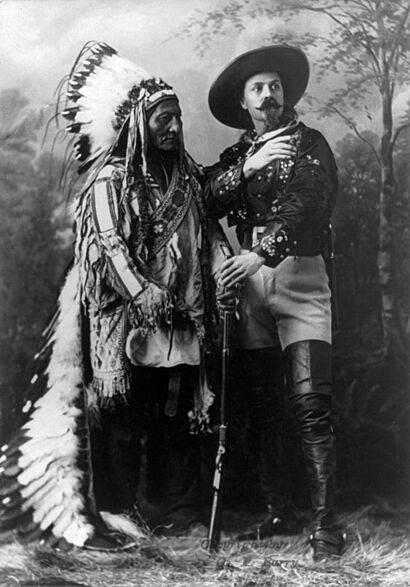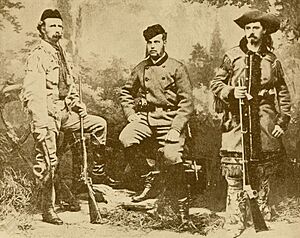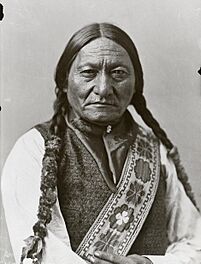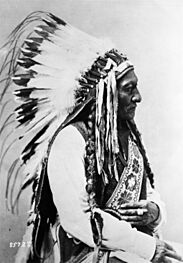Sitting Bull and Buffalo Bill facts for kids
Quick facts for kids Sitting Bull and Buffalo Bill |
|
|---|---|

Restored version of the photograph
|
|
| Artist | William Notman & Son |
| Year | 1885 |
| Medium | Photography (silver salts on glass, gelatin dry plate process) |
| Subject | Sitting Bull, Buffalo Bill |
| Location | Montreal, Quebec, Canada |
Sitting Bull and Buffalo Bill is a famous photograph from 1885. It shows two important figures: Sitting Bull, a leader of the Lakota people, and Buffalo Bill, a well-known entertainer. The picture was taken in Montreal, Canada, at the studio of photographer William Notman. Both men were in Montreal because Sitting Bull was part of Buffalo Bill's popular show, Buffalo Bill's Wild West.
This black-and-white photo shows Sitting Bull and Buffalo Bill standing in front of a painted forest background. Buffalo Bill looks out into the distance, while Sitting Bull stands still. Nine years before this photo, these two men were on opposite sides during the Great Sioux War of 1876. Because of this, the photo was often called "Foes in '76, Friends in '85". This image is seen as a very important part of American history and culture. It is also one of the last photos taken of Sitting Bull, who passed away in 1890.
Contents
Who Were Sitting Bull and Buffalo Bill?
Buffalo Bill's Early Life
William Frederick Cody, known as Buffalo Bill, was a soldier, hunter, and showman. He was a supporter of George Armstrong Custer, a famous cavalry commander. In 1876, Custer led his soldiers, the 7th Cavalry Regiment, against Native American tribes. These tribes were led by Sitting Bull. This event was part of the Great Sioux War of 1876. The battle, known as the Battle of the Little Bighorn, was a big victory for the Native Americans. Custer was killed during this battle.
After the battle, Buffalo Bill joined another group of soldiers. He became famous as a showman by acting out his part in a small fight called the Battle of Warbonnet Creek.
Sitting Bull Joins the Wild West Show
Nine years later, in 1885, Sitting Bull was living on a reservation in South Dakota. He had returned there after living in Canada for a while. Buffalo Bill invited Sitting Bull to join his show, Buffalo Bill's Wild West. This show had started touring two years earlier. Sitting Bull agreed to join. The American government also allowed him to go, as it was a way for him to leave the reservation.
During the shows, Sitting Bull would simply ride around the arena. Sometimes, the crowds would boo him. However, when the show came to Montreal, Canada, on August 10, 1885, the crowds did not boo. The show stayed in Montreal for one week in the Pointe-Saint-Charles area.
Taking the Famous Photo
While in Montreal, Sitting Bull and Buffalo Bill had a photo session. This was done to help promote the show. The photos were taken at the studio of William Notman & Son. The studio's founder, William Notman, was famous for taking pictures of well-known people. We don't know for sure who took the photo Sitting Bull and Buffalo Bill. However, experts believe Notman himself was likely involved.
Later, in 1887, an American photographer named David Francis Barry copyrighted the photo. When Sitting Bull and Buffalo Bill was published, it had the caption "Foes in '76, Friends in '85". This caption referred to how Sitting Bull and Buffalo Bill were enemies during the Great Sioux War of 1876.
What the Photo Shows
In the photograph, Sitting Bull is on the left and Buffalo Bill is on the right. They are standing on a floor covered with hay. Behind them is a painted background that looks like a thick forest. Sitting Bull wears a large headdress. Both men are holding a Winchester rifle together by its barrel.
Neither of them is looking directly at the camera. Sitting Bull looks down and seems very still. He is turned slightly towards Buffalo Bill. Buffalo Bill looks off into the distance, as if looking at something far away. His right hand is near his chest, and his left foot is stepping forward.
Why This Photo is Important
Many people see Sitting Bull and Buffalo Bill as a "mythical photograph." It is considered an "icon of American popular culture". Historian Jean-François Nadeau called it "the most famous photograph of the Western legend". This photo, along with others taken at the same time, are some of the last pictures of Sitting Bull. He was killed by American police in 1890.
Images for kids






